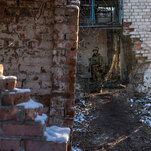
What Does Russia Want in Ukraine? The Tensions Explained

The United States, NATO and Russia have been engaged in a whirlwind of diplomacy aimed at averting the largest military action in Europe since World War II. Here’s a guide to what’s at stake.


It feels like a scene from the Cold War.
An unpredictable Russian president amassing thousands of troops on the border of a neighboring country, Ukraine. The threat of invasion. A possible bloody conflagration between East and West.
But what may seem like a perilous episode from a bygone era is now front and center in global diplomacy as the United States jockeys to deter a Russian incursion into Ukraine.
The situation intensified over the weekend as it emerged that President Biden was considering deploying several thousand U.S. troops, as well as warships and aircraft, to NATO allies in the Baltics and Eastern Europe. The move appeared to signal a shift from the Biden administration which has taken pains to avoid provoking Russia.
But with President Vladimir V. Putin of Russia ramping up his threats and talks between American and Russian officials failing to defuse the crisis, the administration appeared to be changing tack.
Russia has mobilized about 100,000 troops near its border with Ukraine. The United States has disclosed intelligence showing that Russia has a war plan envisioning an invasion force of 175,000 troops that Ukraine’s military, despite U.S.-provided equipment and training, would have little ability to stop.
Mr. Biden has said that an invasion would be “the most consequential thing that’s happened in the world in terms of war and peace since World War II.” Current intelligence assessments described by White House officials conclude that Mr. Putin has not made a decision about whether to invade. And so far, none of the military options being considered include deploying additional American troops to Ukraine itself.
A potential military flare-up threatens to destabilize the already volatile post-Soviet region, buffeted by the popular revolt this month in Kazakhstan. It would also have serious consequences for the security structure that has governed Europe since the collapse of the Soviet Union three decades ago.
Russia has made a list of far-reaching demands, including that NATO pledge to halt further eastward expansion and agree not to admit Ukraine as a member. But the United States has called those positions unacceptable. Russian officials have repeatedly insisted that Moscow has no plans to invade Ukraine and that the massive troop buildup is just for exercises.
Essentially, Mr. Putin is seeking to redraw the post-Cold War boundaries of Europe, establishing a broad, Russian-dominated security zone and drawing Ukraine back into Moscow’s orbit by force, if necessary.
In the event of an invasion, the United States and its allies have threatened to impose a series of sanctions that would go far beyond those imposed in 2014, after the Russian annexation of Crimea. Mr. Putin has warned that imposing new sanctions could lead to a “complete rupture” in relations with Washington.
What’s behind the Ukraine crisis?
Image
Tensions between Ukraine and Russia have been simmering since 2014. That’s when Ukraine ousted its pro-Russian president and the Russian military crossed into Ukrainian territory, annexing Crimea and fomenting a rebellion by separatists in eastern Ukraine. A tenuous cease-fire was reached in 2015, but peace has been elusive amid a grinding war that has killed more than 13,000 soldiers and civilians.
The Kremlin’s position toward its neighbor has been hardening, as Mr. Putin has grown more insistent that Ukraine is fundamentally a part of Russia, culturally and historically. Concerns were raised in late October, when Ukraine used an armed drone to attack a howitzer operated by Russian-backed separatists in eastern Ukraine. Russia called the strike a destabilizing act that violated the cease-fire agreement.
What does Mr. Putin want?
Image
Now 69 years old and edging toward the twilight of his political career, Mr. Putin is determined to burnish his legacy and to correct what he has long viewed as a catastrophe of the 20th century: the disintegration of the former Soviet Union.
Asserting Moscow’s power over Ukraine, a country of 44 million people that was previously part of the Soviet bloc and shares a 1,200-mile border with Russia, is part of his aim of restoring what he views as Russia’s rightful place among the world’s great powers, along with the United States and China.
Mr. Putin has increasingly portrayed NATO’s eastward expansion as an existential threat to his country, and insists that Moscow’s military buildup is a reaction to Ukraine’s intensifying ties with the alliance. He appears intent on winding back the clock 30 years, to just before the collapse of the Soviet Union.
The timing of Russia’s troop mobilization is perhaps no coincidence. Mr. Putin is seeking to energize nationalist support at home amid a raging pandemic and a stumbling economy. Last year, opposition groups held some of the largest anti-Putin protests in years.
But while some analysts have portrayed Mr. Putin as a wily chess player adroitly manipulating the West, his latest gambit could backfire. NATO could reinforce its military presence in member countries bordering Russia, like the Baltics. And an invasion would invite punishing sanctions that could diminish his support in a country weary of foreign adventures.
In Ukraine, meanwhile, Moscow’s aggressive posture has further inflamed nationalist passions, with citizen militias preparing for a drawn-out guerrilla campaign in the event of a Russian occupation. And if Mr. Putin’s aim is to reassert Russia’s sphere of influence, invading Ukraine would further destabilize the post-Soviet region, where Russian troops are helping restore order in Kazakhstan and Belarus is still smoldering after an uprising in 2020.
How does the United States plan to respond?
Image
In early December, Mr. Biden made clear that his administration was not considering sending troops to Ukraine, since, among other reasons, Ukraine is not a member of the NATO alliance and does not come under its commitment to collective defense.
Understand the Escalating Tensions Over Ukraine
Card 1 of 5
Instead, Mr. Biden has said that he would reinforce the American military presence in NATO countries that border Russia. And, referring to Mr. Putin, he has promised that there would be “economic consequences like none he’s ever seen.”
Mr. Biden is considering several options that would shift American military assets much closer to Mr. Putin’s doorstep. The options include sending 1,000 to 5,000 troops to Eastern European countries, with the potential to increase that number tenfold if things deteriorate.
Biden officials have also recently warned that the United States could throw its weight behind a Ukrainian insurgency should Mr. Putin invade Ukraine.
U.S. officials have hinted that Washington could be turning to its China playbook — potentially instituting sanctions that could deprive Russians of their beloved next-generation phones, laptops and other gadgets, and the military from advanced equipment. There is also the option of cutting Russia off from the international banking system, though analysts have said that is unlikely.
An intensifying conflict in Ukraine would test the resolve of the Biden administration as the United States has been working to restore confidence in America’s global leadership following the recent messy withdrawal from Afghanistan and its retrenchment from foreign engagements under President Donald J. Trump.
How the United States handles Russia and Ukraine will affect its ongoing efforts at rebuilding frayed ties with NATO allies after the Trump presidency, during which Mr. Trump declared the alliance “obsolete.”
An escalating crisis in Ukraine also threatens to upend recent efforts by the United States and NATO to shift the alliance’s attention to the security challenge posed by China, and would push it back toward its traditional role of protecting Europe and, by extension, North America.
What’s at stake for Europe?
Image
At stake for Europe is whether it can allow Mr. Putin to upend the security structure that has helped keep the peace on the continent since World War II. And with Europeans divided over how to respond to various forms of Russian aggression, the conflict has also laid bare the weakness of the European Union and its failure as a foreign policy force in international relations.
With the departure of Chancellor Angela Merkel, who grew up in the east, speaks fluent Russian, and had developed a good working relationship with Mr. Putin, Europe lost an invaluable interlocutor with Moscow.
Europe has important trade ties with Russia, and would stand to lose far more than the U.S. from sanctions imposed after a Russian invasion of Ukraine. It is also dependent on Russian gas supplies, a weakness that Mr. Putin has exploited in past disputes.
Steven Erlanger in Brussels contributed reporting.
Source: https://www.nytimes.com/article/russia-ukraine-nato-europe.html















